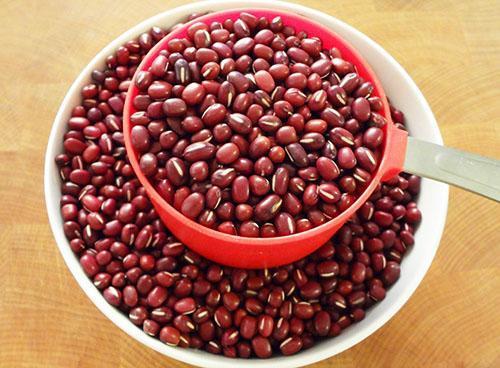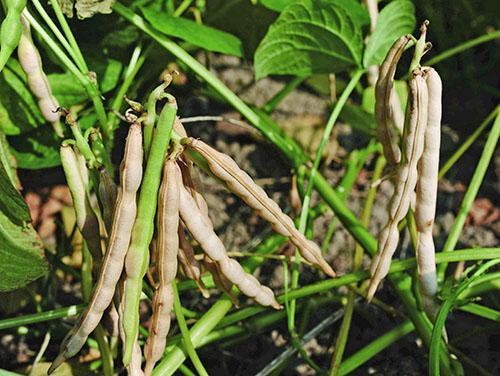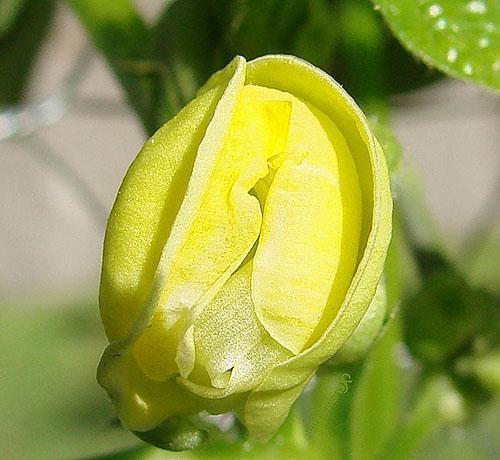Japan's popular Azuki beans
 Along with the American continent, the Asian region has become the largest center for the distribution of all kinds of legumes. Popular in Japan, Azuki beans have also been discovered and cultivated in Southeast Eurasia.
Along with the American continent, the Asian region has become the largest center for the distribution of all kinds of legumes. Popular in Japan, Azuki beans have also been discovered and cultivated in Southeast Eurasia.
Today it is difficult to say where exactly people first tasted the sweetish taste of small red-brown seeds of this species, it is only clear that this happened several thousand years before the new era. Japan and Nepal are fighting for the right to be called the homeland of Azuki, although at present wild related subspecies are found not only in these countries, but also in Korea, southeast China and Taiwan.
The antiquity and spread of culture is also evidenced by the fact that, in addition to the Japanese name for beans that is widespread throughout the world, in China, Korea, Vietnam and even in certain states of India, the species has its own historical name.

Today, adzuki beans are actively grown not only in the Asian region, but also in a number of African countries, in Madagascar and the Seychelles, where the climate allows this useful heat-loving species to fully mature.
Description of the biological characteristics of Azuki beans
 The adzuki bean belongs to the legume family and, in accordance with the accepted classification, is a representative of the vigna genus. Azuki or Vigna angular is a herbaceous annual plant, in culture it looks like dense bushes, up to 90 cm high. Wild varieties are more often curly forms that, when in contact with the ground, can easily attach with the help of roots formed at the nodes.
The adzuki bean belongs to the legume family and, in accordance with the accepted classification, is a representative of the vigna genus. Azuki or Vigna angular is a herbaceous annual plant, in culture it looks like dense bushes, up to 90 cm high. Wild varieties are more often curly forms that, when in contact with the ground, can easily attach with the help of roots formed at the nodes.
The main taproot reaching a length of 50 cm. On the stems, dense three-lobed leaves with pointed ends are alternately located. The racemose inflorescences of adzuki beans, combining from 2 to 20 flowers, are formed on the peduncles developing in the axils. The flowers are medium-sized, bisexual, of bright yellow color, they can self-pollinate, but sometimes insects also participate in the formation of the ovary. Mass flowering lasts up to 40 days, and under favorable conditions, plants can re-release flower stalks up to three times and bring additional harvest.
After pollination, a cylindrical pod narrowed towards the tip is formed, 5 to 13 cm long. The pod is only 5–6 mm thick. If the young ovaries of the adzuki bean are densely lowered, then the mature pods, containing 5–14 seeds each, are almost naked. Cylindrical, rounded beans seeds, for the sake of which the culture is grown, do not exceed 5–8 mm in length, and reach 5.5 mm in diameter.
 The color that gave the beans one of the names is most often really red, wine-colored, but there are variegated, brown and cream seeds. They retain their germination capacity for at least five years, and begin to germinate at temperatures not 6–10 ° C.
The color that gave the beans one of the names is most often really red, wine-colored, but there are variegated, brown and cream seeds. They retain their germination capacity for at least five years, and begin to germinate at temperatures not 6–10 ° C.
For successful growth, flowering and fruiting of adzuki beans, a temperature of 25–34 ° C is required. The growing season lasts 60–190 days, depending on the variety and climatic conditions of cultivation.
Composition of Azuki beans
 This type of beans is loved by many Asians due to the delicate nutty aroma of the seeds and their sweetish taste.What is the composition of adzuki beans, and what to expect from the dishes prepared with them? It turns out that the exotic type of legumes is quite interesting not only from a botanical, but also from a dietary point. For 100 grams of mature adzuki seeds, there are:
This type of beans is loved by many Asians due to the delicate nutty aroma of the seeds and their sweetish taste.What is the composition of adzuki beans, and what to expect from the dishes prepared with them? It turns out that the exotic type of legumes is quite interesting not only from a botanical, but also from a dietary point. For 100 grams of mature adzuki seeds, there are:
- 13.4 grams of moisture;
- 19.9 grams of protein;
- 62.9 grams of carbohydrates;
- 12.7 grams of fiber;
- 0.5 grams of fat.
It is reasonable to note that a food that is so rich in carbohydrates should have a high energy value. Indeed, the calorie content of red adzuki beans is 329 kcal.
But, besides this, the oval red seeds contain calcium and iron, phosphorus and magnesium, zinc, potassium and other trace elements. Adzuki is rich in vitamin A and thiamine, riboflavin and niacin, vitamin B6 and folate. The amino acid composition of a valuable food product is also interesting. The concentration of fatty acids in 100 grams of seeds is 113 mg linoleic 50 mg and oleic acid.
 The cultivation of adzuki beans contributes to the enrichment of the soil with nitrogen, this crop is recognized as an excellent forage plant. But how is this type of beans useful for a person?
The cultivation of adzuki beans contributes to the enrichment of the soil with nitrogen, this crop is recognized as an excellent forage plant. But how is this type of beans useful for a person?
What are the benefits of Azuki beans?
 The rich microelement, amino acid and vitamin composition of the adzuki beans could not be overlooked by doctors and everyone who tries to adhere to the rules of a healthy diet. Due to the abundance of active substances in the seeds, dishes made from them contribute to:
The rich microelement, amino acid and vitamin composition of the adzuki beans could not be overlooked by doctors and everyone who tries to adhere to the rules of a healthy diet. Due to the abundance of active substances in the seeds, dishes made from them contribute to:
- improving the work of the heart and blood vessels;
- a change for the better in blood composition;
- stimulation of the synthesis of erythrocytes;
- protection of the body from environmental influences and the development of tumor processes;
- removing excess fluid from the body, as a result, relieving swelling and reducing the load on a number of internal organs;
- effective cleansing of the body from toxins and excess cholesterol;
- improve motor skills gastrointestinal tract;
- rapid saturation of the body with the most accessible and essential substances for life.
Today, the antitumor and hepatoprotective effect of red bean extracts is being actively studied.
Women in Asian countries, where they are well aware of the benefits of beans, use adzuki to enhance lactation, and seed flour is used in a number of traditional cosmetics, as well as in preparations for improving skin and hair. Azuki is a valuable food product, which is confirmed by both the calorie content of red beans and their composition. But when eating carbohydrate-rich dishes from this type of legumes, it is extremely important to know when to stop and take into account possible contraindications.
Azuki - a tool of fashion and shocking
 In addition to their nutritional and medicinal value, adzuki beans have proven to be able to inspire a unique subculture. In 2007, Japanese artist Takao Sakai launched an eccentric project that became world famous over time. Takao's photographs of people with beards from Japan's traditional adzuki bean elicited smiles and questions from millions of viewers.
In addition to their nutritional and medicinal value, adzuki beans have proven to be able to inspire a unique subculture. In 2007, Japanese artist Takao Sakai launched an eccentric project that became world famous over time. Takao's photographs of people with beards from Japan's traditional adzuki bean elicited smiles and questions from millions of viewers.
Today, the playful project of the Japanese has gone beyond the limits allotted to him, and in the Land of the Rising Sun there are more than one and a half million people who at least once tried on a beard made of caramelized red bean seeds.
 As Sakai himself admitted, he did not think that his idea would become a fashion trend. But the media around the world that picked up the news quickly spread unusual photographs and, probably, helped the birth of extravagant fashion.
As Sakai himself admitted, he did not think that his idea would become a fashion trend. But the media around the world that picked up the news quickly spread unusual photographs and, probably, helped the birth of extravagant fashion.
Azuki beans in cooking
 As for the direct use of beans, adzuki beans are a traditional component of many dishes in Japanese, Chinese and Vietnamese cuisine. The seeds are actively used in Korea, Malaysia, and now in a number of African countries.
As for the direct use of beans, adzuki beans are a traditional component of many dishes in Japanese, Chinese and Vietnamese cuisine. The seeds are actively used in Korea, Malaysia, and now in a number of African countries.
At the same time, the seeds are used both in ripe and green form. In the West and in Korean cuisine, dishes made from sprouted grains are popular.
There are many ways to prepare red beans, and, like mung beans, this variety of cowpea does not need to be presoaked, and the seeds can be brought to readiness in 40 minutes of cooking.
The sweet specific taste of boiled seeds determined the main purpose of red beans, which are actively used in confectionery.
 A mass of grated boiled seeds is an excellent filling for classic pies, pancakes and rice balls so beloved in the East.Even ice cream is made on the basis of healthy red beans, crushed beans are replaced with cocoa and coffee, making a delicious and very nutritious drink.
A mass of grated boiled seeds is an excellent filling for classic pies, pancakes and rice balls so beloved in the East.Even ice cream is made on the basis of healthy red beans, crushed beans are replaced with cocoa and coffee, making a delicious and very nutritious drink.
 Adzuki beans take pride of place among the products used in ritual food served on major events and holidays. An example of this are the Sakura mochi patties, which consist of a shell of rice dough and a reddish bean filling. This delicacy traditionally appears on the Japanese table in the spring, when the girls' holiday is celebrated.
Adzuki beans take pride of place among the products used in ritual food served on major events and holidays. An example of this are the Sakura mochi patties, which consist of a shell of rice dough and a reddish bean filling. This delicacy traditionally appears on the Japanese table in the spring, when the girls' holiday is celebrated.
 In China, you can taste sweet bean soup, which, in addition to adzuki, requires water, a little vanilla and brown sugar. The dish is decorated with lotus or sesame seeds, as well as candied grains of the most red beans.
In China, you can taste sweet bean soup, which, in addition to adzuki, requires water, a little vanilla and brown sugar. The dish is decorated with lotus or sesame seeds, as well as candied grains of the most red beans.